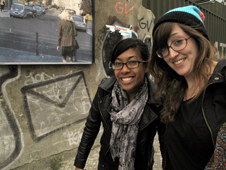Designing social change

Ann McDonald, associate professor of art and design at Northeastern University, always encourages her students to create pieces that have the power to ignite global conversations about religion, ethnicity and sexual orientation.
Two of her star pupils—Kate Terrando and Christie O’Laughlin, both AMD’10—acted on these words of wisdom.
During a two-week symposium in Berlin last summer, the pair collaborated with students from China, Germany, Israel, Russia, Poland and England to design a multimedia exhibition called “Culture, Migration and Representation.”
In July, the exhibition won the 2011 Design Education Initiatives Award from the design magazine Core77.
As one member of the international jury put it, the exhibition’s “philosophy of social democracy has the potential to foster transformation through the promotion of empathy, mutual understanding and social justice.”
The project was part of an ongoing initiative called Sticks + Stones, created in 2006 by McDonald and colleagues at Weber State University and the University of Maryland, College Park.
Graphic designers, McDonald noted, should assume proactive roles in support of community and society. “Our job is to find a way to visually communicate difficult issues to the broader public so that we may open up a dialogue,” she explained.
“Students must think of themselves as instigators and find ways for design to make a difference in the world,” McDonald said. “Visual communication can reach across cultures and disarm people in ways that can be very powerful.”
Terrando and O’Laughlin enjoyed the chance to collaborate with students from around the world.
“The best part of collaborating with others is the mutual learning that goes on,” said Terrando, who acted as curator of the international exhibition and now designs graphics for Small Design Firm, in Cambridge, Mass. “The project challenged me to ask myself and those around me better questions.”
O’Laughlin, who currently teaches English to students in Thailand, attended the Berlin symposium through an Office of the Provost undergraduate research grant. For the exhibition, she designed information graphics that explored the relationship between the birthplace of immigrants in the United States and the kind of job they held.
For her, the project generated as many questions as answers. “We had a great discussion about how stereotypes impact us,” she said. “But the difficult question to answer is why people continue to stereotype. Is everyone guilty of judging one another?”




